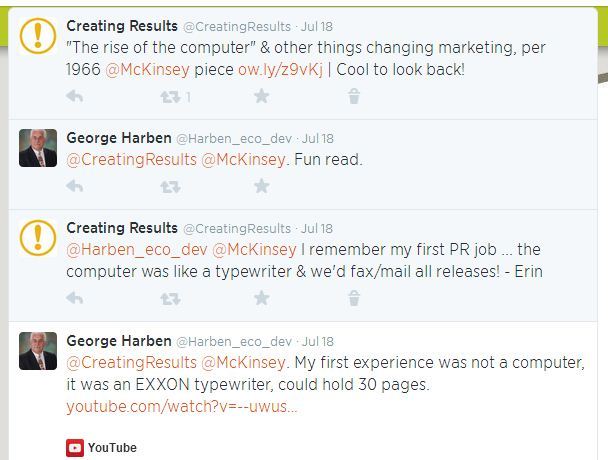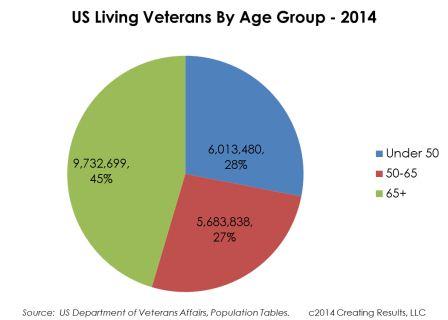On this date in 1930, President Herbert Hoover established the Veterans Administration. There are an estimated 21,972,964 living US Veterans, and it’s a decidedly gray group — 72% are over the age of 50.
As we wrote on this blog back in 2009, senior veterans are educated, adaptable and everywhere. Since that post another half a million veterans entered the 65+ block, which means their health needs are have only increased.
(Does your organization’s marketing program consider the values and perspectives of elder veterans?)
Don’t want until November 11 to thank a Veteran. Do it today.
Now, on to the week’s top mature marketing links.
1. MOST SHARED: Roughly 9 million Americans over 44 are working in “encore” jobs, using skills and earning a living, reports the Chicago Tribune. Some do so by choice — this is how they want to spend their retirement. Others by necessity — they found themselves involuntarily retired.
“… 9% of the 100 million people [ages 44 to 70] work in encore jobs, according to a 2011 survey by Encore.org, a nonprofit organization, and the MetLife foundation. An additional 31 million would like to …
The share of older Americans in the workforce has risen sharply since the mid-1990s, and polls show millions of people plan to work in years that once were classified as retirement.”
Read the article: http://trib.in/WyunAu
RELATED: Un-Retiring Presidents
2. MOST CLICKED: McKinsey & Company recently posted an article from its archives — 1966, to be precise — that looked at the “changing face of marketing.” The analysis of six major trends struck a chord with me … and with Creating Results’ followers on Twitter who clicked through and responded.
Many of the changes identified by McKinsey consultant John D. Louth in 1966 continue to be strong forces in marketing today.
1. The dominance of the customer – Louth wrote that “the end users of almost every company’s products are shifting in makeup, location, and number at an ever-increasing rate. The significance of this to senior marketing executives is twofold: First, they cannot—indeed, they must not—assume that yesterday’s customers will be available tomorrow. Second, they had better be certain that they have adequate sources of market information.”
Todd Harff and I have stressed this point in a series of presentations to senior living associations this year. Pointing out the best practices of global brands such as Nordstrom and Marriott, we emphasize that continuing care retirement communities (CCRCs) cannot base today’s selections and offerings on what residents who moved in 10 years ago like. Or even those who arrived 2 years ago. CCRCs must be thinking of what people who will move in 2 years from now want.
2. The spread of marketing research – “Beyond this value in reporting on historical and current conditions, however, I see a trend toward increased use of marketing research as a creative tool to help solve future management problems.” Well put, Mr. Louth!
3. The rise of the computer – “Generally speaking, I think it must be conceded that companies have dragged their feet in taking advantage of electronic data-processing analyses, online communications, and information-retrieval systems as tools to help make marketing more efficient.” The more things change …
4. Expanded use of test marketing – Louth notes that with rising costs of introducing new products and packaging and training salespeople, market tests can “narrow the odds of an error.”
5. Metamorphosis of field selling – Could Louth have imagined today’s network marketing? Every month I am invited to join or host a house party featuring baskets, jewelry, kitchen ware, natural skin care. At times the “party” is a one-day event promoted on Facebook.
6. Global market planning – “For the smaller company, this trend may emphasize the need to establish or strengthen export relationships so that it too may market on a worldwide basis. For many larger companies, it points to a day when the United States may be merely a domestic division within the worldwide corporation,” wrote Louth. Even CCRCs are not immune to globalization. The smartest ones are looking at what innovative, successful ideas are being implemented around the world, and then applying those learnings closer to home.
Read McKinsey’s archive feature: http://bit.ly/1kLELdB
The piece got a few of us flashing back, as you can see in this exchange with George Harben, of Prince William County Economic Development.

Then George won the internet with the video he shared:
What do you think of the 6 marketing changes ID’d by McKinsey in 1966? Do they resonate with your challenges today? Please share your insights below.



